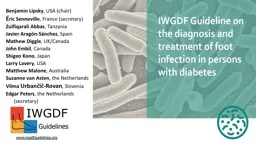

chair É ric Senneville France secretary Zulfiqarali Abbas Tanzania Javier AragónSánchez Spain Mathew Diggle UKCanada John Embil Canada Shigeo Kono ID: 814698
Download The PPT/PDF document "Benjamin Lipsky , USA (" is the property of its rightful owner. Permission is granted to download and print the materials on this web site for personal, non-commercial use only, and to display it on your personal computer provided you do not modify the materials and that you retain all copyright notices contained in the materials. By downloading content from our website, you accept the terms of this agreement.
Slide1
Benjamin Lipsky, USA (chair)Éric Senneville, France (secretary)Zulfiqarali Abbas, TanzaniaJavier Aragón-Sánchez, SpainMathew Diggle, UK/CanadaJohn Embil, CanadaShigeo Kono, JapanLarry Lavery, USAMatthew Malone, AustraliaSuzanne van Asten, the NetherlandsVilma Urbančič-Rovan, SloveniaEdgar Peters, the Netherlands (secretary)
www.iwgdfguidelines.org
Slide2IWGDF Infection Working Group 2019SennevilleVan Asten
Peters
Lipsky
Aragón-
Sánchez
Lavery
Abbas
Embil
Diggle
Malone
Kono
Urbančič-
Rovan
Slides
courtesy
IWGDF;
available
at:
www.iwgdfguidelines.org
Slide3History of IWGDF Foot Infection GuidelinesDiagnosing and treating diabetic foot infections. Lipsky BA, Berendt AR, Embil J, De Lalla F. Diabetes Metab Res Rev. 2004;20 Suppl 1:S56-64Specific guidelines for treatment of diabetic foot osteomyelitis. Berendt AR, Peters EJ, Bakker K, Embil JM, Eneroth M, Hinchliffe RJ, Jeffcoate WJ, Lipsky BA, Senneville E, Teh J, Valk GD. Diabetes Metab Res Rev. 2008;24 Suppl 1:S190-1Expert opinion on the management of infections in the diabetic foot. Lipsky BA, Peters EJ, Senneville E, Berendt AR, Embil JM, Lavery LA, Urbančič-Rovan V, Jeffcoate WJ; IWGDF. Diabetes Metab Res Rev. 2012;28 Suppl 1:163-78
IWGDF guidance on the diagnosis and management of foot infections in persons with diabetes. Lipsky BA, Aragón-Sánchez J, Diggle M, Embil J, Kono S, Lavery L, Senneville É, Urbančič-Rovan V, Van Asten S, Peters EJ; International Working Group on the Diabetic Foot.
Diabetes Metab Res Rev. 2016;32 Suppl 1:45-74
Slides
courtesy
IWGDF;
available
at:
www.iwgdfguidelines.org
Slide4What’s New in the 2019 Infection Guidelines?Committee members: 2 new (diabetologist; podiatrist), 10 returning; now representatives from 8 countries, 5 continentsSystematic reviews: first review of diagnosis of infection; update of previous review of interventions for infectionInfection severity classification: first change; osteomyelitis removed from “moderate” and has separate designation
“O”Format: Changed from largely category
style to using “PICOs”Updates: 4 tables (
infection
classification
scheme
;
characteristics
of
serious infection ; features of osteomyelitis on plain X-
rays; empiric antibiotic regimens); 1 algorithm (overview of management)
Slides
courtesy IWGDF; available at:
www.iwgdfguidelines.org
Slide5Recommendations: total of 27Topic - Treatment: 17 11 on antimicrobials 2 on surgery 3 on osteomyelitis 2 on adjunctive treatments - Diagnosis: 9 (3 specifically regarding osteomyelitis) - Management: 1 (hospitalization)
Strength: 16 strong; 11 weakQuality: 17 low; 9 moderate; 1 high
Slides
courtesy
IWGDF;
available
at:
www.iwgdfguidelines.org
Slide6Key Recommendations: DiagnosisAssess all diabetic foot ulcers (wounds) using the IDSA/IWGDF classificationHospitalize patient if serious infection; outpatient treament adequate for many moderate & most mild infectionsHelpful clinical diagnostic tests: probe-to-bone test; serum inflammatory markers (especially CRP & ESR, ± PCT)
Culture tissue (not swab) specimens of infected (
not uninfected) wounds using standard (rather than molecular) methods
Sample
bone
if
needed
for
definitive diagnosis of osteomyelitis or to determine causative
pathogen(s) & susceptibiltiy resultsPlain X-rays often
sufficient for imaging; if advanced imaging needed MRI usually best, or consider WBC scintigraphy or PET/CT
Slides
courtesy IWGDF; available
at: www.iwgdfguidelines.org
Slide7Key Recommendations: Treatment 1Treat infections with antibiotics shown to be effective in clinical trialsSelect agent(s) based on: likely pathogen(s) & susceptibilites; clinical severity of infection; published evidence of efficacy; risk of adverse events or drug interactions; bone involvement; availability; costTreat parenterally
for severe infections initially; switch to oral agents
(if appropriate one available) when patient stable.
Treat
with
oral
agents
for mild and most moderate infections
Using available topical antimicrobials is not supported by published
dataTherapy duration: 1-2 weeks usually adequate for soft tissue; ≤6 weeks for bone
infection (5-7 days if all osteomyelitis resected)
Slides courtesy
IWGDF; available at:
www.iwgdfguidelines.org
Slide8Key Recommendations: Treatment 2In temperate climates for patients with no recent antibiotic therapy, target only aerobic GPCs (S. aureus, β-streptococcus)In tropical/subtropical climates, or if recent antibiotic therapy, add coverage for aerobic GNRs (possibly including Pseudomonas), and possibly for obligate anaerobics (especially
if limb ischemia)Do not treat
clinically uninfected wounds with antimicrobialsA surgeon should
urgently
evaluate
all
severe,
and
many moderate infections, especially if ? gangrene
, abscess, compartment syndromeMany cases of forefoot osteomyelitis can be
treated medically, but surgical resection (preferably conservative) may be best
for others
Slides courtesy IWGDF;
available at: www.iwgdfguidelines.org
Slide9Key Recommendations: Treatment 3During surgery to resect infected bone, it is likely useful to obtain a “marginal” sample to ensure residual bone uninfected; if not, treatAdjunctive therapies have not (yet) been shown to be effective for treating
the infectious aspects of diabetic foot wounds,
including: hyperbaric oxygen; G-CSF; topical antiseptics; negative pressure
wound
therapy
;
bacteriophages
For
complicated
cases
seek input from infectious diseases/
clinical microbiology clinicians and multidisciplinary teamsMost appropriately treated
infections can be sucessfully treated, but relapses and reinfections are common
Slides
courtesy IWGDF; available
at: www.iwgdfguidelines.org
Slide10Key ControversiesWhat is the best approach to imaging bone & soft tissue infectionsIs obtaining marginal bone after resection helpful for selecting best treatmentIs “wound bioburden” a definable or useful conceptWhen might molecular (genotypic) microbiology techniques be usefulHow to monitor treatment & limit antibiotic duration (soft tissue & bone infxn)How
to adapt approaches to DFI management in low-income countriesWhen
might topical/local antimicrobial therapy be useful
How
to
determine
the
presence
and treatment of biofilm infection
Slides courtesy
IWGDF; available at:
www.iwgdfguidelines.org
Slide11Thank youSlides courtesy IWGDF; available at: www.iwgdfguidelines.org
Slide12www.iwgdfguidelines.orgBenjamin A. Lipsky, USA (chair) Shigeo Kono, JapanÉric Senneville, France
(secretary) Lawrence A. Lavery,
USAZulfiqarali G. Abbas,
Tanzania
Matthew Malone,
Australia
Javier Aragón-Sánchez,
Spain
Suzanne A. van
Asten
,
Netherlands
Mathew Diggle,
UK
/
Canada Vilma Urbančič-Rovan
, SloveniaJohn M. Embil,
Canada Edgar J.G. Peters,
Netherlands (secretary)IWGDF Guideline on the Diagnosis and Treatment of Foot Infection in People with Diabetes
Slides
courtesy
IWGDF;
available
at:
www.iwgdfguidelines.org